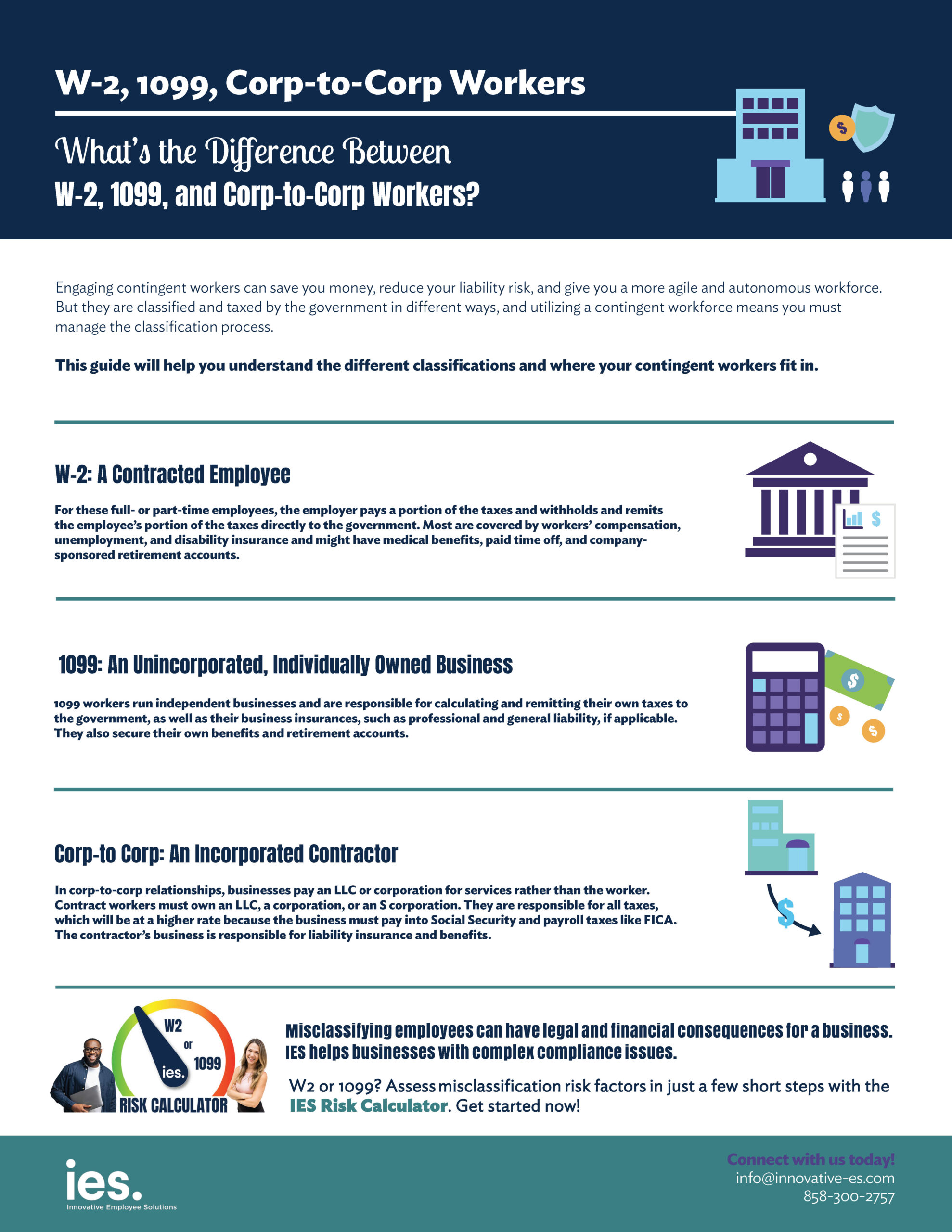What’s the Difference Between W-2, 1099, and Corp-to-Corp Workers?
Posted on February 1st, 2019 Read time: 3 minutes

It’s easy to see the upside to contract employment as a business owner. Hiring contingent workers can save you money, reduce your liability risk, and give you a more agile and autonomous workforce. But hiring contingent workers also puts a new burden on your HR operations that you may not have thought of: employee classification.
Contingent workers are classified and taxed by the government in different ways, and hiring them also means you have to manage this classification process. Misclassifying employees can have dire legal and financial consequences for a business. The fine for an intentional misclassification can be a penalty of equal to 100 percent of the taxes owed. Ouch.
If you don’t understand classification, you shouldn’t engage contingent workers, and if you don’t use contingent workers, you won’t reap the many benefits they offer. To help, IES has prepared a quick guide to help you understand the different classifications and where your contingent workers fit in.
W-2: A Contracted Employee
A W-2 employee is what you might generally think of as a full- or part-time employee. If the work hours are set by the company, training is provided by the company, the equipment is provided by the company, the workload is assigned by a supervisor, the worker is required to meet set standards, and the worker has a single employer, then that worker is a W-2 employee.
For these workers, the employer pays a portion of the taxes and withholds and remits the employee’s portion of the taxes directly to the government as well. Additionally, most W-2 employees are covered by workers’ compensation, unemployment, and disability insurances, and many employers offer additional employee benefits such as medical benefits, paid time off, and company-sponsored retirement accounts.
1099: An Unincorporated, Individually Owned Business
In broad strokes, a 1099 independent contractor is the flip side of a W-2 employee. 1099 workers set their own schedules, accept or decline their own assignments, complete assignments using their own methods, provide their own equipment, and are free to provide their services to more than one client.
Because they are running an independent business, these workers are responsible for calculating and remitting their own taxes to the government, as well as their business insurances, such as professional and general liability, if applicable. They are also responsible for securing their own benefits and any individual retirement accounts. Their clients are contracting them for a service and have no employer-employee obligations.
Corp-to Corp: An Incorporated Contractor
If you’re using a corp-to-corp relationship with someone, it just means that you’ll pay an LLC or corporation for services rather than the individual worker. (That’s where the name comes from — your “corp” will be paying the worker’s “corp.”) A contract worker under a corp-to-corp agreement must own an LLC, a corporation, or an S corporation.
Similar to a 1099 independent contractor, the contracted worker under this arrangement is responsible for all taxes, which will be at a higher rate because of the business’s obligation to pay into Social Security and payroll taxes like FICA. The contractor’s business is responsible for any liability insurance, and a corp-to-corp contractor sets his or her own benefits. One of the biggest differences between a 1099 contractor and a corp-to-corp is the misclassification risk reduction it can offer to clients by contracting with a vetted corporation rather than an individual.
Let’s break it down in a quick reference cheat sheet!
IES developed a free interactive assessment tool called the Risk Calculator to help you determine your risk level when engaging workers. Learn your risk level within minutes. Take the assessment now: innovativeemployeesolutions.com/riskcalculator
Still not sure? IES is here to help. If you could use some outside expertise in handling your contingent employees, contact us today. Let’s start the discussion! Email us at info@innovative-es.com or call 858-300-2757.
Written By: Sara Jensen, Vice President of Business Development at IES
Sara Jensen is vice president of business development for Innovative Employee Solutions (IES), a leading global Employer of Record in more than 150 countries that specializes in contingent workforce solutions such as outsourced payrolling, independent contractor compliance, and contractor management services. Founded in 1974, IES has grown into one of San Diego’s largest women-owned businesses and has been named one of the city’s “Best Places to Work” for 10 years in a row.







